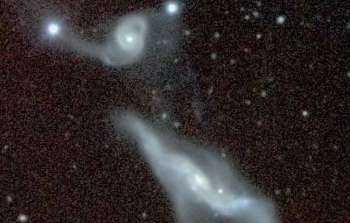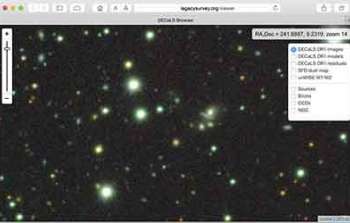sci15001 — Announcement
DECam Legacy Survey Announces First Data Release
May 31, 2015
The interacting galaxy system UGC 12589 at a distance of 473 million light years in the constellation of Pisces, as imaged by the DECam Legacy Survey (DECaLS). The distorted morphologies of the two galaxies result from the interaction and the faint, diffuse light is from tidally stripped stars. This false-color image was constructed from the g-, r- and z-band images by Kevin Napier and John Moustakas of Siena College. DECaLS is imaging approximately one-sixth of the sky using the Dark Energy Camera on the Blanco Telescope at the Cerro Tololo Inter-American Observatory.
The DECam Legacy Survey (DECaLS) is delivering a new publicly available dataset that will allow astronomers to probe the structure of the Milky Way, the nature of dark energy, and many other topics in astrophysics. The survey leads David Schlegel (Lawrence Berkeley National Laboratory) and Arjun Dey (NOAO) recently announced the first data release from the survey.
Designed to be significantly deeper (g=24.7, r=23.9, z=23.0 AB) and to have better image quality than the earlier Sloan Digital Sky Survey (SDSS) or Pan-STARRS surveys, DECaLS covers 6700 square degrees of extragalactic sky (-20 < δ < +30 degrees) using the Dark Energy Camera (DECam) on the Blanco Telescope. The imaging survey overlaps the SDSS/BOSS extragalactic footprint. As a result, DECaLS imaging complements the spectroscopic trove of 2.5 million extragalactic objects from the SDSS, SDSS-II, SDSS-III/BOSS and SDSS-IV/eBOSS surveys.
This combination of imaging and spectroscopy will allow the survey team to study the Milky Way halo and its satellite galaxies as well as the dark and baryonic matter distributions in galaxy halos. Beyond these immediate goals, DECaLS imaging will also provide valuable input into target selection for the future Dark Energy Spectroscopic Instrument (DESI) survey, which aims to provide spectra of additional tens of millions of galaxies and QSOs.
The survey team has challenged itself to release reduced data and catalogs within months of taking the data in order to maximize the science impact of the survey. The DECam data included in the first data release (DR1) were obtained primarily from Aug 2014 to Jan 2015. DR1, made in June 2015, covers a disjoint 3100 square degree footprint of the survey area (in at least one filter) and describes the properties of approximately 140 million unique sources. Stacked image bricks and catalogs are available at the survey website. Calibrated single-epoch images are available through the NOAO Survey Archive. Future data releases are anticipated at 6-month intervals.
DECaLS Sky Viewer
Images from DR1 can be perused using the DECaLS Sky Viewer, which displays images from DECaLS and NASA’s Wide-field Infrared Survey Explorer (WISE). Built by Dustin Lang (Carnegie Mellon University), Sky Viewer uses leaflet, an open source javascript library for interactive maps.
Robust Catalogs
Catalogs are constructed using a forward modeling approach, in which objects are detected and represented by simple parametric models and fit to individual images. This process (the Tractor) was developed by Dustin Lang and David Hogg (NYU) to generate catalogs from multi-pass, multi-band imaging data. The Tractor avoids resampling and interpolating data when combining multiple frames and bands, while also preserving the noise properties of the data. In addition, data with widely differing bands and spatial resolution can be combined. The Tractor has been used previously to compare SDSS and WISE imaging data (Lang et al. 2014; arXiv:1410.7397).
Catalogs report fluxes and source morphology (point source, exponential disk, de Vaucoleurs profile, or a composite) for DECaLS data as well as publicly available DES data within the DECaLS footprint (primarily in the region of Stripe 82) and forced photometry for all DECaLS sources from WISE images. Matched catalogs for SDSS photometry and spectroscopy are also included in the data release. Subsequent data releases will include forced photometry (i.e., photometry assuming a source shape and position) for multiple epochs.
Open Source Software
Software used to produce the data products is publicly available. The open data, open software policy was adopted by the survey to encourage creative reuse of the survey products.
Feedback welcome
The survey team welcomes feedback regarding problems or anomalies discovered in the data and data products.
Contacts
DECaLS Google Group
https://groups.google.com/g/decam-legacy-survey?pli=1
About the Announcement
| Id: |
ID
sci15001
|

